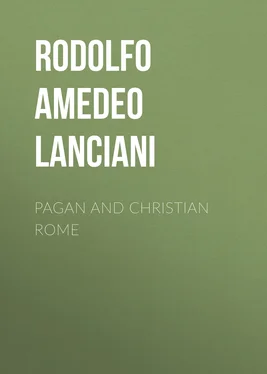Rodolfo Amedeo Lanciani - Pagan and Christian Rome
Здесь есть возможность читать онлайн «Rodolfo Amedeo Lanciani - Pagan and Christian Rome» — ознакомительный отрывок электронной книги совершенно бесплатно, а после прочтения отрывка купить полную версию. В некоторых случаях можно слушать аудио, скачать через торрент в формате fb2 и присутствует краткое содержание. Жанр: foreign_edu, История, История, на английском языке. Описание произведения, (предисловие) а так же отзывы посетителей доступны на портале библиотеки ЛибКат.
- Название:Pagan and Christian Rome
- Автор:
- Жанр:
- Год:неизвестен
- ISBN:нет данных
- Рейтинг книги:3 / 5. Голосов: 1
-
Избранное:Добавить в избранное
- Отзывы:
-
Ваша оценка:
- 60
- 1
- 2
- 3
- 4
- 5
Pagan and Christian Rome: краткое содержание, описание и аннотация
Предлагаем к чтению аннотацию, описание, краткое содержание или предисловие (зависит от того, что написал сам автор книги «Pagan and Christian Rome»). Если вы не нашли необходимую информацию о книге — напишите в комментариях, мы постараемся отыскать её.
Pagan and Christian Rome — читать онлайн ознакомительный отрывок
Ниже представлен текст книги, разбитый по страницам. Система сохранения места последней прочитанной страницы, позволяет с удобством читать онлайн бесплатно книгу «Pagan and Christian Rome», без необходимости каждый раз заново искать на чём Вы остановились. Поставьте закладку, и сможете в любой момент перейти на страницу, на которой закончили чтение.
Интервал:
Закладка:
There can scarcely be any doubt that the emperor Philip the Arab (Marcus Julius Philippus, a. d. 244), his wife Otacilia Severa, and his son Philip the younger were Christians, and friends of S. Hippolytus. Still, in spite of these periods of peace and freedom of the Church, we cannot be blind to the fact that for a Christian nobleman wishing to make a career, the position was extremely hazardous. Hence we frequently see baptism deferred until mature or old age, and strange situations and even acts of decided apostasy created by mixed marriages.
The wavering between public honors and Christian retirement is illustrated by some incidents in the life of Licentius, a disciple of S. Augustine. Licentius was the son of Romanianus, a friend and countryman of Augustine; and when the latter retired to the villa of Verecundus, after his conversion, in the year 386, Licentius, who had attended his lectures on eloquence at Milan, followed him to his retreat. He appears as one of the speakers in the academic disputes which took place in the villa. 12 12 The name of the villa was Cassiacum ; its memory has lasted to the present age. See the memoir of Luigi Biraghi, S. Agostino a Cassago di Brianza. Milano, 1854.
In 396, Licentius, who had followed his master to Africa, seduced by the hopes of a brilliant career, determined to settle in Rome. Augustine, deeply grieved at losing his beloved pupil, wrote to call him back, and entreated him to turn his face from the failing promises of the world. The appeal had no effect, and no more had the epistles, in prose and verse, addressed to him for the same purpose by Paulinus of Nola. Licentius, after finishing the course of philosophy, being scarcely a catechumen, and a very unsteady one at that, entered a career for public honors. Paulinus of Nola describes him as aiming not only at a consulship, but also at a pagan pontificate, and reproaches and pities him for his behavior. After this, we lose sight of Licentius in history, but a discovery made at S. Lorenzo fuori le Mura in December, 1862, tells us the end of the tale. A marble sarcophagus was found, containing his body, and his epitaph. This shows that Licentius died in Rome in 406, after having reached the end of his desires, a place in the Senate; and that he died a Christian, and was buried near the tomb of S. Lorenzo. This sarcophagus, hardly noticed by visitors in spite of its great historical associations, is preserved in the vestibule of the Capitoline Museum.
Inscription found near the Porta del Popolo, 1877.
As regards mixed marriages, a discovery made in 1877, near the Porta del Popolo, has revealed a curious state of things. In demolishing one of the towers by which Sixtus IV. had flanked that gate, we found a fragment of an inscription of the second century, containing these strange and enigmatic words: "If any one dare to do injury to this structure, or to otherwise disturb the peace of her who is buried inside, because she, my daughter, has been [or has appeared to be] a pagan among the pagans, and a Christian among the Christians" … Here followed the specification of the penalties which the violator of the tomb would incur. It was thought at first that the phrase quod inter fedeles fidelis fuit, inter alienos pagana fuit had been dictated by the father as a jocose hint of the religious inconsistency of the girl; but such an explanation can hardly be accepted. A passage of Tertullian in connection with mixed marriages leads us to the true understanding of the epitaph. In the second book Ad Uxorem, Tertullian describes the state of habitual apostasy to which Christian girls marrying gentiles willingly exposed or submitted themselves, especially when the husband was kept in ignorance of the religion of the bride. He mentions the risks they would incur of betraying their conscience by accompanying their husbands to state or civil ceremonies, thus sanctioning acts of idolatry by the mere fact of their presence. In the book De Corona, he concludes his argument with the words: "These are the reasons why we do not marry infidels, because such marriages lead us back to idolatry and superstition." The girl buried on the Via Flaminia, by the modern Porta del Popolo, must have been born of a Christian mother and a good-natured pagan father; still, it seems hardly consistent with the respect which the ancients had for tombs that he should be allowed to write such extraordinary words on that of his own daughter.
We must not believe, however, that gentiles and Christians lived always at swords' points. Italians in general, and Romans in particular, are noted for their great tolerance in matters of religion, which sometimes degenerates into apathy and indifference. Whether it be a sign of feebleness of character, or of common sense, the fact is, that religious feuds have never been allowed to prevail among us. In no part of the world have the Jews enjoyed more freedom and tolerance than in the Roman Ghetto. The same feelings prevailed in imperial Rome, except for occasional outbursts of passion, fomented by the official persecutors.

Inscription in a tomb of the Via Severiana at Ostia.
An inscription was discovered at Ostia, in January, 1867, in a tomb of the Via Severiana, of which I append an accurate copy.
The tomb and the inscription are purely pagan, as shown by the invocation to the infernal gods, Diis Manibus. This being the case, how can we account for the names of Paul and Peter, which, taken separately, give great probability, and taken together give almost absolute certainty, of having been adopted in remembrance of the two apostles? One circumstance may help us to explain the case: the preference shown for the name of Paul over that of Peter; the former was borne by both father and son, the latter appears only as a surname given to the son. This fact is not without importance, if we recollect that the two men who show such partiality for the name of Paul belong to the family of Anneus Seneca, the philosopher, whose friendship with the apostle has been made famous by a tradition dating at least from the beginning of the fourth century. The tradition rests on a foundation of truth. The apostle was tried and judged in Corinth by the proconsul Marcus Anneus Gallio, brother of Seneca; in Rome he was handed over to Afranius Burro, prefect of the prætorium, and an intimate friend of Seneca. We know, also, that the presence of the prisoner, and his wonderful eloquence in preaching the new faith, created a profound sensation among the members of the prætorium and of the imperial household. His case must have been inquired into by the philosopher himself, who happened to be consul suffectus at the time. The modest tombstone, discovered by accident among the ruins of Ostia, gives us the evidence of the bond of sympathy and esteem established, in consequence of these events, between the Annei and the founders of the Church in Rome.
Its resemblance to the name of the Annei reminds me of another remarkable discovery connected with the same city, and with the same question. There lived at Ostia, towards the middle of the second century, a manufacturer of pottery and terracottas, named Annius Ser......, whose lamps were exported to many provinces of the empire. These lamps are generally ornamented with the image of the Good Shepherd; but they show also types which are decidedly pagan, such as the labors of Hercules, Diana the huntress, etc. It has been surmised that Annius Ser...... was converted to the gospel, and that the adoption of the symbolic figure of the Redeemer on his lamps was a result of his change of religion; but to explain the case it is not necessary to accept this theory. I believe he was a pagan, and that the lamps with the Good Shepherd were produced by him to order, and from a design supplied to him by a member of the local congregation.
Читать дальшеИнтервал:
Закладка:
Похожие книги на «Pagan and Christian Rome»
Представляем Вашему вниманию похожие книги на «Pagan and Christian Rome» списком для выбора. Мы отобрали схожую по названию и смыслу литературу в надежде предоставить читателям больше вариантов отыскать новые, интересные, ещё непрочитанные произведения.
Обсуждение, отзывы о книге «Pagan and Christian Rome» и просто собственные мнения читателей. Оставьте ваши комментарии, напишите, что Вы думаете о произведении, его смысле или главных героях. Укажите что конкретно понравилось, а что нет, и почему Вы так считаете.












